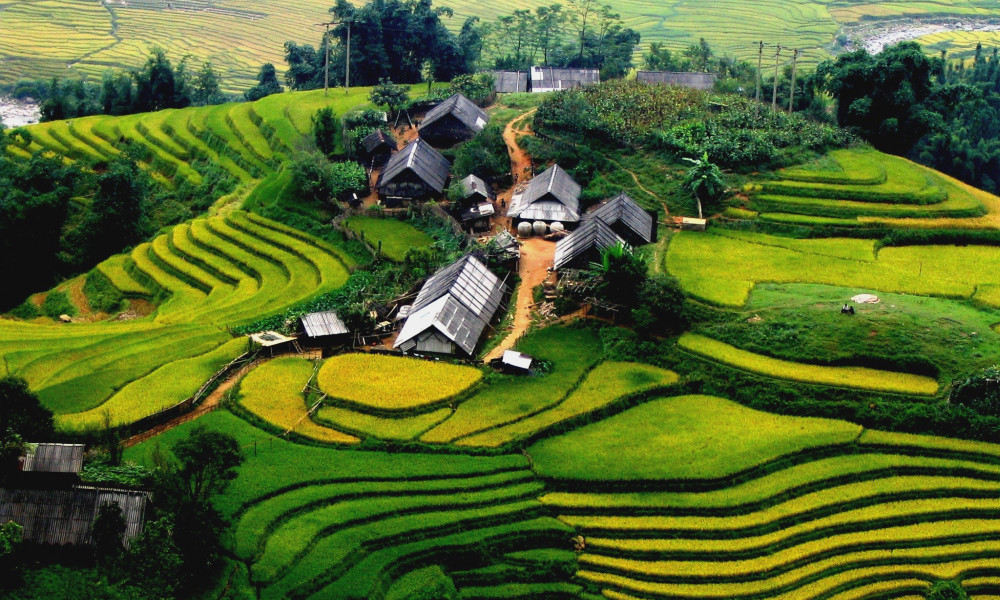Rice fields: Grains of unbelievable beauty

China: fields with dragon names
The plains and slopes of the mountains, at first glance, are unshakable and impregnable. But the people of China are not looking for easy ways, and therefore it is here that travelers are brought in — take a look at the rice fields. From 200 to 2000 meters above sea level in the province of Yunnan, they cultivate a culture that is alien to the achievements of technology, and all work is done manually. Local guides respectfully relate to nature: they say, without its help, such nutritious and useful beauty will not come true. Photo fullhdoboi.ru
Photo fullhdoboi.ru
Water flows down from the mountain tops and floods the holes preventing the emergence of weeds, and so nature itself creates the best conditions for ripening rice. Further work is donw with men's arms. Rice grains are grown in special greenhouses and then filled with each well. The fields are submerged from November to April, and from the outside it seems that they absorb the energy of the sun and the moon reflecting the celestial surface on the earth. But in spring and autumn the terraces “adjust” to the colors of the seasons turning the space into soft transitions from soft pastel colors to bright reflections of the autumn sun. Photo 24warez.ru
Photo 24warez.ru
The most famous plantation in China "Dragon Range" is located twenty-seven kilometers from the city of Longshen. The old-timers of this town say: “Where there is land, there will be a rice terrace,” however, the process of creating “grain paintings” in this region dragged on for four centuries. The Yuan dynasty which ruled the open spaces in the 13th century gathered whole "folk regiments" that were supposed to sow the mountain hills with rice. In gratitude, they were given a mature culture to feed themselves and their family. As the crown of the dynasty, this natural treasure was passed from father to son. When "Dragon Ridge" took the form that has come down to our days, the Chinese drew attention to an interesting fact. From a height of 800 meters, it seems like a hill has sheltered a sleeping dragon with a serpentine spine that has captured rice fields.
Another story is a game with flowers. Fields, like a chameleon, change them depending on their mood. Flooded with water, they take on a hint of reverie, putting on a soft blue surface - this is how spring comes to China. In the fall, the crop ripens and the slopes of the mountains flicker with a golden glow, and the rice terraces themselves look like hilly waves. But in winter, nothing disturbs the peace of these places - the fields are covered with snow, clean and untouched.
Read also: Chinese sugar painting: Art from a ladle
Japan: rice rebel figures
Japanese people perfectly mastered the art of painting in rice fields. So, in the town of Inakadat which is located in Aomori prefecture every year is organized an extraordinary “exhibition” of huge “pictures” that appeared on the rice terrace. Plots for paintings are diversive. From the bird's eye view you can see the rider - this is the warrior Sengoku who saddled his horse. Napoleon gallops somewhere far away - his figure is “turned” with the help of various types of rice (usually wild rice is used for such “pictures”, as well as varieties of Basmati, Jasmine and Arborio). Photo rutravel.net
Photo rutravel.net
Masters who "weave" a fabulous rice carpet are not limited to historical personalities - heroes of TV series, and even vegetable painting created by planting purple and yellow rice, are increasingly appearing on the margins. Photo 4tololo.ru
Photo 4tololo.ru
Read also: Rice canvas. Tambo Art
Bali Island: Rice Goddess Plantations
What kind of food can be imagined without rice! - residents of Bali joke. It is no coincidence that in the language of this nationality the words “food” and “rice” are called in one word - “nasi”. Cereal is not only the main dish of the Balinese but also a culture that helps the population to survive: half of the people living on the island are engaged in its cultivation. Every day there is rice for the people of Bali who prescribe not only the laws of healthy eating, but also ... religious views! Indeed, in Indonesia, Bali is considered the island of the gods, who are supposed to bring grain daily, asking for blessings for the coming day. Locals even have the Rice Goddess, who in the Indonesian beliefs is represented as Devi Sri. Rumor has it, it helps to grow the crop, so sometimes in the middle of the field you can find the altar erected in its glory. Word of mouth conveys the legend, explaining how Devi Sri is associated with this cereal crop being mysterious in its simplicity. Photo vovworld.vn
Photo vovworld.vn
... Dragon Anta worshiped the god Batara but he could not create the material embodiment of his prayers. Once he, trying in vain to make an offering to God, burst into tears, and the tears flowing from his eyes turned into three eggs, one of which he presented to the altar of Batar. From this egg, as the legend goes, a tiny girl appeared who was named Devi Sri. And when over the years she died, on the place where her body rested, rice sprouted from the ground. Batara gathered it and gave it to the people, ordering them to honor cereals in memory of his daughter. And then he vowed that luck would accompany those who worship rice and present it to the gods. Photo clinchem.aaccjnls.org
Photo clinchem.aaccjnls.org
Read also: Kamasan: Village of masterpieces in Bali
Cover photo vietravel.com





















